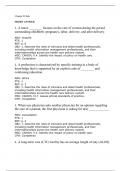Chapter 01.bnk
SHORT ANSWER
1.A nurse ________ focuses on the care of women during the period
surrounding childbirth: pregnancy, labor, delivery, and after delivery.
ANS: midwife
PTS: 1
REF: p. 6
OBJ: 1. Describe the roles of clinicians and allied health professionals,
including health information management professionals, and their
interrelationships across the health care delivery system.
MSC: CAHIIM, V.4. Identify the impact of policy on health care.
OTH: Completion
2.A profession is characterized by specific training in a body of
knowledge that is supported by an explicit code of ________ and
continuing education.
ANS: ethics
PTS: 1
REF: p. 2
OBJ: 1. Describe the roles of clinicians and allied health professionals,
including health information management professionals, and their
interrelationships across the health care delivery system.
MSC: CAHIIM, VI.7. Assess ethical standards of practice.
OTH: Completion
3. When one physician asks another physician for an opinion regarding
the care of a patient, the first physician is asking for a(n) ____________.
ANS: consultation
PTS: 1
REF: p. 4
OBJ: 1. Describe the roles of clinicians and allied health professionals,
including health information management professionals, and their
interrelationships across the health care delivery system.
MSC: CAHIIM, V.4. Identify the impact of policy on health care.
OTH: Completion
4. A long-term care (LTC) facility has an average length of stay (ALOS)
,greater than ___________ days. (Input your answer in numeric value)
ANS: 30
PTS: 1
REF: p. 12 | p. 13
OBJ: 2. Summarize the structure of the health care system, including types
of providers and their patients, third-party payers and the role of the
employer, pharmaceutical companies and device manufacturers, and the
interrelationships working to provide continuity of care.
MSC: CAHIIM, V.4. Identify the impact of policy on health care.
OTH: Completion
5. The actual number of beds that a hospital has available for inpatients
is called the _________.
ANS: bed count
PTS: 1
REF: p. 13
OBJ: 2. Summarize the structure of the health care system, including types
of providers and their patients, third-party payers and the role of the
employer, pharmaceutical companies and device manufacturers, and the
interrelationships working to provide continuity of care.
MSC: CAHIIM, V.4. Identify the impact of policy on health care.
OTH: Completion
6.A health care organization that has permanent facilities, 24-hour
nursing care for inpatients, and an organized medical staff is a type of
_________.
ANS: hospital
PTS: 1
REF: p. 11
OBJ: 2. Summarize the structure of the health care system, including types
of providers and their patients, third-party payers and the role of the
employer, pharmaceutical companies and device manufacturers, and the
interrelationships working to provide continuity of care.
MSC: CAHIIM, V.4. Identify the impact of policy on health care.
OTH: Completion
7. The payment to a health care provider is called _________.
ANS: reimbursement
,PTS: 1
REF: p. 17
OBJ: 2. Summarize the structure of the health care system, including types
of providers and their patients, third-party payers and the role of the
employer, pharmaceutical companies and device manufacturers, and the
interrelationships working to provide continuity of care.
MSC: CAHIIM, V.4. Identify the impact of policy on health care.
OTH: Completion
8.A facility that routinely perform eye surgeries, colonoscopies,
excisions, and many types of orthopedic surgeries on an outpatient basis,
wherein the patient returns home after the procedure is performed is
called a(n) ________ surgery center.
ANS: ambulatory
PTS: 1
REF: p. 12
OBJ: 2. Summarize the structure of the health care system, including types
of providers and their patients, third-party payers and the role of the
employer, pharmaceutical companies and device manufacturers, and the
interrelationships working to provide continuity of care.
MSC: CAHIIM, V.4. Identify the impact of policy on health care.
OTH: Completion
9. _________ health care focuses on treating patients where they reside.
ANS: Home
PTS: 1
REF: p. 13
OBJ: 2. Summarize the structure of the health care system, including types
of providers and their patients, third-party payers and the role of the
employer, pharmaceutical companies and device manufacturers, and the
interrelationships working to provide continuity of care.
MSC: CAHIIM, V.4. Identify the impact of policy on health care.
OTH: Completion
10. Palliative care for the terminally ill is the focus of ________ care.
ANS: hospice
PTS: 1
REF: p. 13
OBJ: 2. Summarize the structure of the health care system, including types
of providers and their patients, third-party payers and the role of the
, employer, pharmaceutical companies and device manufacturers, and the
interrelationships working to provide continuity of care.
MSC: CAHIIM, V.4. Identify the impact of policy on health care.
OTH: Completion
11. A seamless continuity of care with services from many different
providers across a patient's lifespan is called ________ care, which has
yet to be fully realized in practice.
ANS: integrated
PTS: 1
REF: p. 16
OBJ: 2. Summarize the structure of the health care system, including types
of providers and their patients, third-party payers and the role of the
employer, pharmaceutical companies and device manufacturers, and the
interrelationships working to provide continuity of care.
MSC: CAHIIM, V.4. Identify the impact of policy on health care.
OTH: Completion
12.The Centers for Medicare and Medicaid Services waives routine
Conditions of Participation compliance audits for appropriately
accredited facilities by granting them _________.
ANS: deemed status
PTS: 1
REF: p. 22
OBJ: 3. Discuss the external forces that guide policy-making and health care
delivery, including the impact of various levels of government, accreditation
agencies, and professional organizations.
MSC: CAHIIM, V.4. Identify the impact of policy on health care.
OTH: Completion
13.Voluntary compliance with a set of standards developed by an
independent agency is part of the _________ process.
ANS: accreditation
PTS: 1
REF: p. 21
OBJ: 3. Discuss the external forces that guide policy-making and health care
delivery, including the impact of various levels of government, accreditation
agencies, and professional organizations.
MSC: CAHIIM, V.4. Identify the impact of policy on health care.




